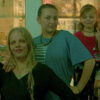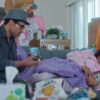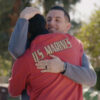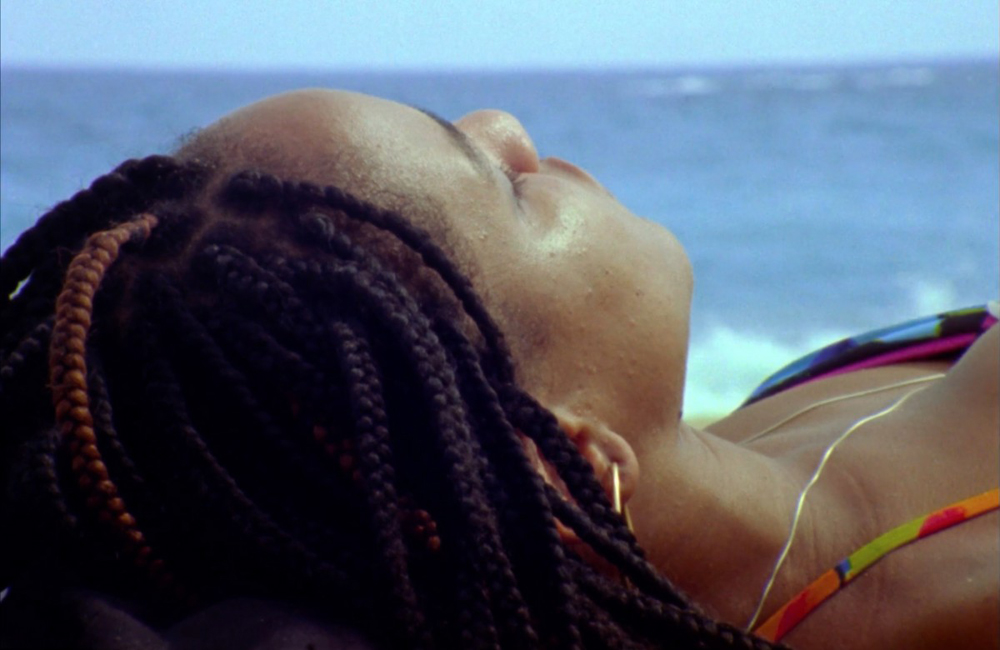After the dazzling and dizzying opening sequence that introduces you to Rebeca Huntt in the autobiographical doc “Beba,” a flurry of images past and present blitz the screen at the same rate as you might imagine them bombarding the young Afro-Latina woman walking down the streets of her native New York, began to take shape, the filmmaker and subject knew the best way to continue throwing an audience off-balance was land somewhere completely still and to sit in the moment.
“I remember saying to Isabel [Freeman, the film’s editor] when there’s the photos, the music comes up, and I’m talking about how my mom and dad met, “Yo, let it just be a soundscape around the photos, so it goes from this weird intro to this very straightforward [family history],” recalls Huntt of finding that moment to breathe. “The film plays a lot and I feel so lucky to have been able to play like that because this is my dream — to write and direct films.”
In the case of “Beba,” the term “dream” comes off less a goal than a practice for Huntt and it seems as if it’s destiny when she’s tapped into her unconscious so lucidly in bringing her memories to the screen. As the daughter of a Venezuelan mother and Dominican father who settled in the largely white neighborhood of Central Park West, Huntt describes a life shaped by compromise without ever doing so in the telling of her story, having to code switch for so long after being thrust into a world that looked very different than the one she experienced at home, making her way to Bard College where she could presumably feel at home as an budding artist yet had to put up a fight most of her classmates did not have to be taken seriously as a Black woman.
Asserting herself immediately in “Beba” with a ferocious voiceover as just one means of taking control over a narrative that has seemed largely out of her hands up until now, the film sees Huntt turn the dichotomies of her experience into the spark of cinematic epiphanies, coming to understand why her parents never left a humble one-bedroom apartment as the family grew to five in order to take advantage of its tony address, returning to Central America where she could reconnect with her heritage with wizened eyes and pulling inspiration from a variety of cultural influences ranging from Audre Lorde to Bob Dylan while honing her own voice as an artist as the film unspools. Committed to warm, tactile 16mm film stock, “Beba” feels as if something deeply internal is being brought out, exhilarating when the sense of discovery for an audience of its director’s talent occurs at the same rate as her own self-actualization.
As intimidating as it may have been for Huntt to put herself out there in the way she has with her feature debut, shining a light into corners of her relationships with family and friends that surely were difficult to discuss, the filmmaker has found getting personal has had the most universal resonance as “Beba” made its premiere last fall at Toronto and this week took Berlinale by storm before its release later this year in the U.S. via Neon. Graciously taking some time away from the film’s big European launch, Huntt spoke about crafting a cinematic language to express what words long could not about her experience, finding collaborators who could handle such personal material with sensitivity and perspective and embracing the limitations of shooting on celluloid.
Not necessarily in terms of time, but in terms of what it would take to process all that you do in this, did you know from the start what an undertaking it would be?
Not at all. I thought it would be done in six months to a year, and I had no idea what I was getting myself into, but it just felt like something I very much felt called to work on. I wanted to connect with people, which is the reason why I made this film and when it comes to filmmaking, which is my love, I’m very much not a product thought thinker, but process thought because there are just certain things you have to turn off, otherwise you can’t get anything done. Especially with a film where I had to peel back the layers of vulnerability, I was very conscious and protective of my thoughts.
Were you always planning on taking such a central role within the film?
Yeah, that was always my plan, but the things that I was going to explore changed throughout. That was also in the peeling back process of “Okay, if I want to explore this relationship with the boyfriend I have right now, I’m feeling that, but why is this coming up? Where does this come from? Oh okay, it’s this.” And I’ve kept a journal since I was old enough to write and the first thing I did with Sofia Geld, my producer, is to look through a bunch of journal entries and I and come up with what would be the most interesting for what we’re doing, so that’s how we started.
Then the writing process took years. I loved the writing process. I’m definitely a writer and I had great influences. I remember reading “Citizen” by Claudia Rankine and that was where I was going with it for a while and then there are so many different references to writers in the film. There’s obvious references to Shakespeare and J.D. Salinger, but then in the Venezuela part when I say, “This is the only place I have unconditional love and a room of my own,” I’m referencing Virginia Woolf’s “A Room of One’s Own” and I was very influenced by Maya Angelou and the list goes on and on. It was really fun. It was obviously frustrating sometimes because I was trying something so different and I still had the three-act structure in mind, so I was looking to have these existential climatic moments and still fit into that classic three-act structure, but it was incredible and I grew so much from it and grew so much from peeling back the layers of vulnerability in the writing. That was a whole other thing on top of it that was happening and it was intense.
I heard a great story about your three-minute short “1 800-Loveable” where you literally had only three minutes’ worth of film – and it’s not a single take film, but you figured out how to utilize every second of it. When you’re using 16mm for this, is it at all counterintuitive to have to be intentional about capturing the moments that you wanted to?
Yeah, how long we were able to shoot on the Bolex obviously is hard, but 16mm film reminds me of intimacy. I know this is a weird thing to say, but if you think about an intimate moment maybe with a partner or someone you’re intimate with in a bed, what you’re seeing most likely [is] a body part with the light hitting a certain way – you’re not getting a full [view]. What your eyes are seeing is super specific, even on your own body, so when it came to portraying some of the more intimate moments in the film, 16mm is limited like that. It’s a limited projection, just like in your eyes when you’re in the face of this intimacy, and what [16mm] does with light is just otherworldly. It’s just sensational and so pulsating, so that’s why it made sense.
You mentioned Sofia Geld earlier, but what was it like putting a team together when I imagine the demands go beyond the usual considerations of filmmaking for such a personally sensitive project?
It’s an ongoing process figuring out collaborations and this and that because they’re so important in filmmaking. Sophia Geld was around from the very beginning and I was just very lucky to have met people like Sophia Stieglitz [the film’s cinematographer] and I, [where] two days after we met, we went on a road trip through Oaxaca and camped with no camping gear in a national park, and Isabel [Freeman, the film’s editor], we emotionally understand each other. We don’t say much to each other. Even in the edit room, there wasn’t much talking per se, but there was a profound emotional understanding and depth there that was just so special. She’d come in and I’d be like, “Isabel, wait, whoa…” [looking at a cut] and she was great at being honest. And that’s so necessary in any collaboration. I didn’t have a yes team in that sense. As much as I led the vision and it was something that was coming from me in a lot of ways, I worked with some really strong, brilliant women that made their mark and put their souls into this as well.
Was there anything that you may have felt you were holding back on, but you or your team pushed you to put it into the film and you’re glad you did now?
The film, in general, makes me squirm, especially because when people watch it, they feel like they know me and not really. It’s a portrayal of me when I’m in my twenties and at this point I’m 31, so I feel very different than the Beba I was on screen, even though she’s totally me and I love her. I get it, but everything about it is critch for me, to be honest.
It makes me especially grateful you’re putting it out there and the bravery it takes. What’s it like getting to this point and seeing it on the big screen?
Seeing myself on screen I feel is a part of something bigger. It’s not necessarily seeing myself on screen that excites me at all, but getting to share this with the world when it’s taken so much time and so many beautiful collaborations. It was a vision that I had that was brought to life and I really did it to connect with people and to be able to do that [now], I just feel so unbelievably grateful and lucky, but also unbelievably proud of myself. I’ll have these little moments where I’ll just remember certain moments of making of the film and I’m like, “Oh my God, I just want [myself] in that moment, I wish I could just tell you, you got this. I love you so much. Thank you for pulling through because here you are.” It’s huge. I’m having a blast. I can’t complain.
“Beba” will screen at Berlinale on February 17th at 8 pm at HKW and February 20th at 5 pm at Cubix 8. It will be released in the U.S. later this year by NEON.




